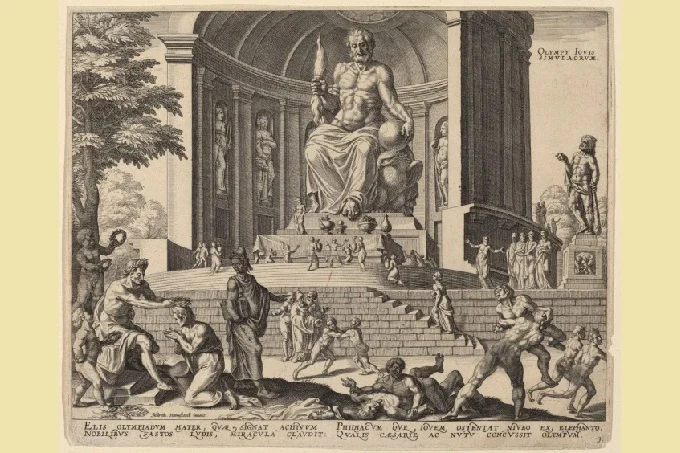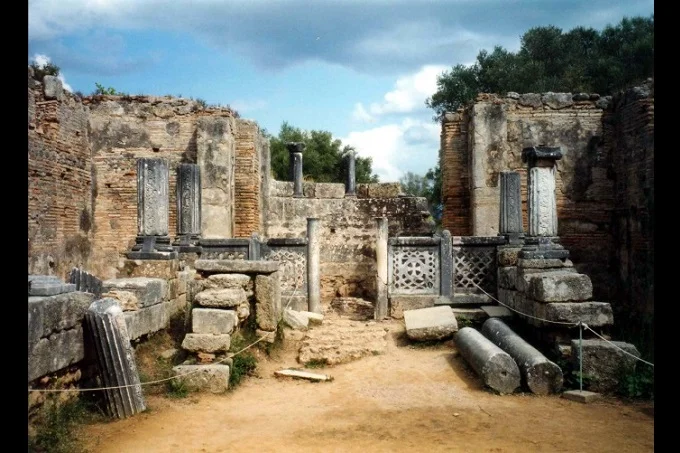The statue of Zeus in Olympia: A lost miracle, shrouded in myths and legends

The statue of Zeus in Olympia is still considered one of the Seven Wonders of the Ancient World and a masterpiece of Phidias, the greatest sculptor of antiquity. Unfortunately, it was destroyed under unknown circumstances at some point in late antiquity.
However, its thousand-year history is surrounded by legends and mysteries. Some stories are as strange as they are entertaining, like the one in which the murder of the Roman emperor Caligula was predicted. Further in the article, about what the creation of the ancient Greek sculptor is and why it was so priceless.
Statue of Zeus, one of the Seven Wonders of the World
When Alexander the Great breathed his last fight in 323 BC, he left behind a huge empire. Alexander created a world of unprecedented cultural interactions as Hellenic culture spread from Greece to the Siwa oasis and from there to the Indus River.

Greek-speaking travelers of the following centuries continued to write travel diaries and share their experiences and instructions. Some of them even compiled lists of must-visit monuments, which they called Amata (lover), and later Taumata (miracles).
The list of monuments that are now known as the Seven Wonders of the Ancient World belongs to Antipater of Sidon (about 100 BC) and Philo of Byzantium (2nd century BC). These lists varied depending on the traveler and his experience. One of the most famous miracles was the statue of Zeus in Olympia.
Phidias
There was no greater sculptor than Phidias (the beginning of the V century – about 430 BC) for the ancient Greeks. In fact, he was the first sculptor who dared to depict the gods using precious materials such as gold and ivory. It was he who led the construction program of the Athenian Acropolis and created a large chryselephantine statue of Athena made of ivory and gold in the Parthenon.
Immediately after the completion of the statue of Athena, enemies accused the sculptor of embezzlement of funds. But in the end, Phidias was cleared of the charges, proving that he used the right amount of gold on the statue. And yet he failed to fend off the second wave of accusations. Apparently, he depicted himself and Pericles on the shield of the goddess, which was a great arrogance. To escape this time, Phidias had to leave Athens.

It was probably this misfortune that led the sculptor to the sanctuary of Zeus in Olympia. The sanctuary was under the protection of the city of Elis. Seeing such an opportunity, the Elians asked Phidias to create a statue of Zeus, like no one else, and he did so.
There is also another version, narrated by Plutarch, in which Phidias first visits Olympia to make a statue of Zeus, and then goes to Athens, where he dies in prison. However, both versions agree on one thing: Phidias visited Olympia and created a unique image of Zeus.
The sculpture was bigger than the one he made in Athens. It was also more majestic. There was magnetism in it that almost instantly made the image of Zeus famous. Centuries later, Pliny the Elder would write that it was a work “that no one could ever compare to.”
Statue of Zeus
In the II century AD, Pausanias saw the twelve-meter statue with his own eyes and wrote about it in detail. His description is very valuable: God sits on a throne, and he is made of ivory and gold. On his head is a wreath, which is a copy of the olive branches. In his right hand, he holds a Victory, also created from precious materials, like the statue itself. And in his left hand, god holds a scepter decorated with an eagle. Zeus’ sandals are made of gold, as is his robe, embroidered with animal figures and flowers of beautiful lilies.”
However, what seems to have made a greater impression on Pausanias is the throne of Zeus. He goes on to describe it in great detail: “…The throne is decorated with gold and precious stones, not to mention ebony and ivory. Figures and forged images are drawn on it. There are four Victories presented in the form of dancing women, one at each foot of the throne and the other two at the base of each foot…”
In front of the throne, the Elians held a pool filled with oil. The oil protected the statue from Olympia’s moisture and helped keep it in good condition. Similarly, on the Athenian Acropolis, where the climate was dry, the Athenians used a pool of water to preserve the chryselephantine statue of Athena.
The Greek artist Panaenos, the nephew of Phidias, helped in the creation of the statue “in relation to the colors with which it was decorated, and especially the drapery.” He also painted the panels that covered the front of the statue’s base.
According to legend, when someone asked Phidias what inspired him to create a statue of Zeus, the sculptor replied with the following verse from Homer’s Iliad (I.528-530): “He said and moved his dark eyebrows. He waved his immortal locks on his head, and the whole Olympus trembled at his nod.”
Even taking into account the testimony of Panaen and the words that inspired the sculptor, it is still not easy to imagine what the statue would look like. Fortunately, his image is found on ancient Greek and Greco-Roman coins, engravings, precious stones, vases, and sculptures.
Interestingly, the statue served as a reference for later depictions of Zeus in the form of a figure with a beard and long hair, the same features, and tradition that can be traced in later Christian depictions of Christ Pantocrator. It is partly reassuring to think that the same Christians who violently destroyed everything of pagan, in a sense, preserved the old tradition with their art.
Pausanias shares some gossip concerning the statue. At the foot of the throne were four rods, on each of which figures were carved. One of these figures, a young man wearing a victory ribbon on his head, was said to have been sculpted in the image of the beautiful Pantarkes, who was said to be the lover of Phidias. Clement of Alexandria (c. 150-215 AD) even claims that Phidias wrote the phrase Pantarkes kalos (“Pantarkes is beautiful”) on the finger of Zeus. This directly implied that the sculptor maintained an erotic relationship with his favorite.
For the ancients, the statue of Zeus was more than just a statue and was considered a version of god on earth. It is not by chance that Pausanias called the statue god, and not a statue or an image. This was not uncommon in ancient Greece and Rome. In fact, it was canon. It was believed that the sculptures of the gods were intermediaries between the kingdom of the gods and people. For example, talking to the statue of Artemis was a way of communicating with the goddess. However, the statue of Zeus has progressed beyond that.
It was believed that the very essence of the divine was imprinted in the image of Zeus. This belief was reinforced by legends, such as the one that claimed that when Phidias finished the statue, he asked Zeus if he was satisfied. In response, thunder crashed from the sky and opened a hole in the ground, which shows that Zeus approved it.
“No, God himself, according to legend, witnessed the artistic skill of Phidias. For when the image was completely finished, Phidias prayed to god that he would show by a sign whether he liked this work. Immediately, the legend says, lightning struck the part of the floor where the bronze jug that covered this place stood to this day.”
Livy says that when the Roman general Lucius Aemilius Paulus visited Olympia, he saw the statue and was thrilled to the depths of his soul when he saw what seemed to be Jupiter himself. Dion (Dio) Chrysostom, a Greek philosopher, and orator of the 1st century AD, wrote that if animals could catch a glimpse of the statue, they would willingly submit to the priest in order to sacrifice themselves to god. Moreover, Dion claimed that whoever stands in front of the statue of Zeus will forget all the horrors and hardships that fall to our human lot.
Nevertheless, some found flaws in the creation of Phidias. Strabo says that the size of the statue was not proportional to the size of the temple. Phidias imagined Zeus sitting so that his head almost touched the roof. But what happens if god decides to leave his temple and rise again? Strabo replies, “He would have taken the roof off the temple!”
According to Roman historians Suetonius and Cassius Dio (Dion), the Roman emperor Gaius Caesar, also known as Caligula, wanted to move the statue of Zeus to Rome and replace its head with his own bust. Suetonius claims that the only reason this didn’t happen was because of Caligula’s murder. He even writes that when the statue was being prepared for shipment to Rome, the statue predicted the death of the emperor when it suddenly burst out laughing so loudly that: “… the scaffolding collapsed, and the workers fled; and immediately a man named Cassius appeared, who stated that in a dream he was told to sacrifice a bull to Jupiter.”
Cassius Dio partially agrees with Suetonius. For him, it was not the death of the emperor that prevented the dismantling of the statue, but the wrath of god: “… the ship built to deliver the statue was destroyed by lightning strikes, and loud laughter was heard every time someone approached as if he wanted to take up the pedestal; accordingly, after threats against the statue, he installed a new statue of himself.”
Obviously, these stories have more in common with legend than with reality. In these narratives, the statue is clearly illustrated as a monument so holy that the very idea of transporting it is arrogance.
Conclusion
In 391 BC, Theodosius banned the cult of pagan gods and closed all pagan places. Since the Olympic Games were banned, Olympia could no longer be the place it once was. In 408 AD, new legislation required the removal of cult statues from their temples.
The old world was not dying, it was collapsing. The statue of Zeus may have survived this wave of destruction, but no one really knows what happened. Most scholars claim that it was moved to Constantinople, where it was lost sometime in the V or VI century.
However, due to its status as one of the Seven Wonders of the Ancient World and the legends that ancient authors spread, the statue of Phidias has been preserved in the art of subsequent centuries. The statue of Zeus in Olympia changed the way the king of the gods was depicted, ultimately creating a visual precedent that even a Christian God would not fail to follow.
All further reconstructions and mentions of the statue in the Assassin’s Creed game clearly indicate that the legend of the statue of Zeus, one of the Seven Wonders of the Ancient World, remains alive for centuries to this day.




